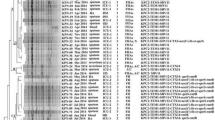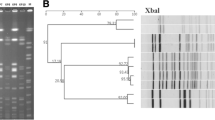Abstract
We report the first outbreak of Klebsiella pneumoniae carbapenemase (KPC)-producing K. pneumoniae in Germany. The presence of KPC was confirmed by polymerase chain reaction (PCR). The KPC-encoding plasmid was analysed by transconjugation experiments, DNA sequencing, Southern blotting and isoelectric focussing. Typing was performed by pulsed-field gel electrophoresis (PFGE). An ertapenem-resistant K. pneumoniae with low minimum inhibitory concentrations (MIC) to other cabapenems (tested by the Vitek system) was isolated from the index patient in January 2008. A KPC-2 was identified after K. pneumoniae with identical susceptibility patterns had been isolated from two more patients. Despite the introduction of infection control measures, transmission occurred in five additional patients and three of the patients died from infections. The source of the outbreak strain remained unclear; however, the Tn4401-containing bla KPC-2 gene was similar to previously described isolates from Greece. Five months after the end of the outbreak, a KPC-K. pneumoniae was isolated from a patient who had been treated in Greece previously. Retrospectively, this patient was treated in November 2007 on the same unit as the index case. Typing revealed that all patients were colonised by the same strain. KPC-K. pneumoniae has been introduced to Germany possibly from Greece and transmission to other institutions is likely.


Similar content being viewed by others
References
Queenan AM, Bush K (2007) Carbapenemases: the versatile β-lactamases. Clin Microbiol Rev 20:440–458
Yigit H, Queenan AM, Anderson GJ, Domenech-Sanchez A, Biddle JW, Steward CD, Alberti S, Bush K, Tenover FC (2001) Novel carbapenem-hydrolyzing beta-lactamase, KPC-1, from a carbapenem-resistant strain of Klebsiella pneumoniae. Antimicrob Agents Chemother 45:1151–1161
Bratu S, Mooty M, Nichani S, Landman D, Gullans C, Pettinato B, Karumudi U, Tolaney P, Quale J (2005) Emergence of KPC-possessing Klebsiella pneumoniae in Brooklyn, New York: epidemiology and recommendations for detection. Antimicrob Agents Chemother 49:3018–3020
Lomaestro BM, Tobin EH, Shang W, Gootz T (2006) The spread of Klebsiella pneumoniae carbapenemase-producing K. pneumoniae to upstate New York. Clin Infect Dis 43:e26–e28, Epub 2006 Jun 19
Bradford PA, Bratu S, Urban C, Visalli M, Mariano N, Landman D, Rahal JJ, Brooks S, Cebular S, Quale J (2004) Emergence of carbapenem-resistant Klebsiella species possessing the class A carbapenem-hydrolyzing KPC-2 and inhibitor-resistant TEM-30 beta-lactamases in New York City. Clin Infect Dis 39:55–60
Woodford N, Tierno PM Jr, Young K, Tysall L, Palepou MF, Ward E, Painter RE, Suber DF, Shungu D, Silver LL, Inglima K, Kornblum J, Livermore DM (2004) Outbreak of Klebsiella pneumoniae producing a new carbapenem-hydrolyzing class A beta-lactamase, KPC-3, in a New York Medical Center. Antimicrob Agents Chemother 48:4793–4799
Naas T, Nordmann P, Vedel G, Poyart C (2005) Plasmid-mediated carbapenem-hydrolyzing beta-lactamase KPC in a Klebsiella pneumoniae isolate from France. Antimicrob Agents Chemother 49:4423–4424
Villegas MV, Lolans K, Correa A, Suarez CJ, Lopez JA, Vallejo M, Quinn JP; Colombian Nosocomial Resistance Study Group (2006) First detection of the plasmid-mediated class A carbapenemase KPC-2 in clinical isolates of Klebsiella pneumoniae from South America. Antimicrob Agents Chemother 50:2880–2882
Pasteran FG, Otaegui L, Guerriero L, Radice G, Maggiora R, Rapoport M, Faccone D, Di Martino A, Galas M (2008) Klebsiella pneumoniae carbapenemase-2, Buenos Aires, Argentina. Emerg Infect Dis 14:1178–1180
Wei ZQ, Du XX, Yu YS, Shen P, Chen YG, Li LJ (2007) Plasmid-mediated KPC-2 in a Klebsiella pneumoniae isolate from China. Antimicrob Agents Chemother 51:763–765
Samra Z, Ofir O, Lishtzinsky Y, Madar-Shapiro L, Bishara J (2007) Outbreak of carbapenem-resistant Klebsiella pneumoniae producing KPC-3 in a tertiary medical centre in Israel. Int J Antimicrob Agents 30:525–529
Leavitt A, Navon-Venezia S, Chmelnitsky I, Schwaber MJ, Carmeli Y (2007) Emergence of KPC-2 and KPC-3 in carbapenem-resistant Klebsiella pneumoniae strains in an Israeli hospital. Antimicrob Agents Chemother 51:3026–3029
Navon-Venezia S, Chmelnitsky I, Leavitt A, Schwaber MJ, Schwartz D, Carmeli Y (2006) Plasmid-mediated imipenem-hydrolyzing enzyme KPC-2 among multiple carbapenem-resistant Escherichia coli clones in Israel. Antimicrob Agents Chemother 50:3098–3101
Cuzon G, Naas T, Demachy MC, Nordmann P (2008) Plasmid-mediated carbapenem-hydrolyzing beta-lactamase KPC-2 in Klebsiella pneumoniae isolate from Greece. Antimicrob Agents Chemother 52:796–797
Tsakris A, Kristo I, Poulou A, Markou F, Ikonomidis A, Pournaras S (2008) First occurrence of KPC-2-possessing Klebsiella pneumoniae in a Greek hospital and recommendation for detection with boronic acid disc tests. J Antimicrob Chemother 62:1257–1260
Tegmark Wisell K, Haeggman S, Gezelius L, Thompson O, Gustafsson I, Ripa T, Olsson-Liljequist B (2007) Identification of Klebsiella pneumoniae carbapenemase in Sweden. Euro Surveill 12:E071220.3
Woodford N, Zhang J, Warner M, Kaufmann ME, Matos J, Macdonald A, Brudney D, Sompolinsky D, Navon-Venezia S, Livermore DM (2008) Arrival of Klebsiella pneumoniae producing KPC carbapenemase in the United Kingdom. J Antimicrob Chemother 62:1261–1264
Maltezou HC, Giakkoupi P, Maragos A, Bolikas M, Raftopoulos V, Papahatzaki H, Vrouhos G, Liakou V, Vatopoulos AC (2009) Outbreak of infections due to KPC-2-producing Klebsiella pneumoniae in a hospital in Crete (Greece). J Infect 58:213–219
Yigit H, Queenan AM, Rasheed JK, Biddle JW, Domenech-Sanchez A, Alberti S, Bush K, Tenover FC (2003) Carbapenem-resistant strain of Klebsiella oxytoca harboring carbapenem-hydrolyzing beta-lactamase KPC-2. Antimicrob Agents Chemother 47:3881–3889
Rasheed JK, Biddle JW, Anderson KF, Washer L, Chenoweth C, Perrin J, Newton DW, Patel JB (2008) Detection of the Klebsiella pneumoniae carbapenemase type 2 carbapenem-hydrolyzing enzyme in clinical isolates of Citrobacter freundii and K. oxytoca carrying a common plasmid. J Clin Microbiol 46:2066–2069
Zhang R, Zhou HW, Cai JC, Chen GX (2007) Plasmid-mediated carbapenem-hydrolysing beta-lactamase KPC-2 in carbapenem-resistant Serratia marcescens isolates from Hangzhou, China. J Antimicrob Chemother 59:574–576
Cai JC, Zhou HW, Zhang R, Chen GX (2008) Emergence of Serratia marcescens, Klebsiella pneumoniae, and Escherichia coli isolates possessing the plasmid-mediated carbapenem-hydrolyzing β-lactamase KPC-2 in intensive care units of a Chinese hospital. Antimicrob Agents Chemother 52:2014–2018
Marchaim D, Navon-Venezia S, Schwaber MJ, Carmeli Y (2008) Isolation of imipenem-resistant Enterobacter species: emergence of KPC-2 carbapenemase, molecular characterization, epidemiology, and outcomes. Antimicrob Agents Chemother 52:1413–1418, Epub 2008 Jan 28
Miriagou V, Tzouvelekis LS, Rossiter S, Tzelepi E, Angulo FJ, Whichard JM (2003) Imipenem resistance in a Salmonella clinical strain due to plasmid-mediated class A carbapenemase KPC-2. Antimicrob Agents Chemother 47:1297–1300
Villegas MV, Lolans K, Correa A, Kattan JN, Lopez JA, Quinn JP; Colombian Nosocomial Resistance Study Group (2007) First identification of Pseudomonas aeruginosa isolates producing a KPC-type carbapenem-hydrolyzing beta-lactamase. Antimicrob Agents Chemother 51:1553–1555
Naas T, Cuzon G, Villegas MV, Lartigue MF, Quinn JP, Nordmann P (2008) Genetic structures at the origin of acquisition of the beta-lactamase bla KPC gene. Antimicrob Agents Chemother 52:1257–1263
Lee K, Chong Y, Shin HB, Kim YA, Yong D, Yum JH (2001) Modified Hodge and EDTA-disk synergy tests to screen metallo-β-lactamase-producing strains of Pseudomonas and Acinetobacter species. Clin Microbiol Infect 7:88–91
Altschul SF, Madden TL, Schäffer AA, Zhang J, Zhang Z, Miller W, Lipman DJ (1997) Gapped BLAST and PSI-BLAST: a new generation of protein database search programs. Nucleic Acids Res 25:3389–3402
Pfaller MA, Hollis RJ, Sader HS (1992) PFGE of chromosomal DNA. In: Isenberg HD (ed) Clinical Microbiological Procedures Handbook. American Society for Microbiology, Washington DC, Section 10.5.c
Tenover F, Arbeit R, Goering R, Mickelsen P, Murray B, Persing D, Swaminathan B (1995) Interpreting chromosomal DNA restriction patterns produced by pulsed-field gel electrophoresis: criteria for bacterial strain typing. J Clin Microbiol 33:2233–2239
Jonas D, Spitzmüller B, Daschner FD, Verhoef J, Brisse S (2004) Discrimination of Klebsiella pneumoniae and Klebsiella oxytoca phylogenetic groups and other Klebsiella species by use of amplified fragment length polymorphism. Res Microbiol 155:17–23
Jonas D, Biehler K, Hartung D, Spitzmüller B, Daschner FD (2005) Plasmid-mediated quinolone resistance in isolates obtained in German intensive care units. Antimicrob Agents Chemother 49:773–775
National Committee for Clinical Laboratory Standards (NCCLS) (1997) Methods for dilution antimicrobial susceptibility tests for bacteria that grow aerobially—Fourth Edition; Approved Standard M7-A4. NCCLS , Wayne, PA
Ejlertsen T, Skov R (1996) The β-lactamases of Moraxella (Branhamella) catarrhalis isolated from Danish children. Acta Pathol Microbiol Immunol Scand 104:557–562
Watanabe M, Iyobe S, Inoue M, Mitsuhashi S (1991) Transferable imipenem resistance in Pseudomonas aeruginosa. Antimicrob Agents Chemother 35:147–151
Wendt C, Jonas D (2008) Klebsiella-pneumoniae-carbapenemase in Deutschland nachgewiesen. Epidemiologisches Bulletin 22:173–174
Wang M, Sahm DF, Jacoby GA, Hooper DC (2004) Emerging plasmid-mediated quinolone resistance associated with the qnr gene in Klebsiella pneumoniae clinical isolates in the United States. Antimicrob Agents Chemother 48:1295–1299
Bratu S, Landman D, Haag R, Recco R, Eramo A, Alam M, Quale J (2005) Rapid spread of carbapenem-resistant Klebsiella pneumoniae in New York City: a new threat to our antibiotic armamentarium. Arch Intern Med 165:1430–1435
Bratu S, Tolaney P, Karumudi U, Quale J, Mooty M, Nichani S, Landman D (2005) Carbapenemase-producing Klebsiella pneumoniae in Brooklyn, NY: molecular epidemiology and in vitro activity of polymyxin B and other agents. J Antimicrob Chemother 56:128–132
Tenover FC, Kalsi RK, Williams PP, Carey RB, Stocker S, Lonsway D, Rasheed JK, Biddle JW, McGowan JE Jr, Hanna B (2006) Carbapenem resistance in Klebsiella pneumoniae not detected by automated susceptibility testing. Emerg Infect Dis 12:1209–1213
Potential conflicts of interest
C.W. is a speaker for Pfizer and BD Diagnostics; M.A.W. is a speaker for Wyeth, Pfizer, MSD, Essex, Gilead, Astra Zeneca and Astellas. All other authors have no conflict of interest to declare.
Author information
Authors and Affiliations
Corresponding author
Rights and permissions
About this article
Cite this article
Wendt, C., Schütt, S., Dalpke, A.H. et al. First outbreak of Klebsiella pneumoniae carbapenemase (KPC)-producing K. pneumoniae in Germany. Eur J Clin Microbiol Infect Dis 29, 563–570 (2010). https://doi.org/10.1007/s10096-010-0896-0
Received:
Accepted:
Published:
Issue Date:
DOI: https://doi.org/10.1007/s10096-010-0896-0




